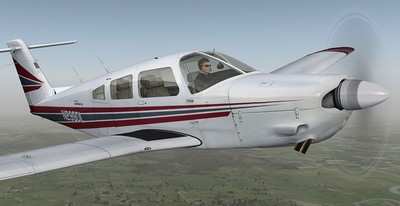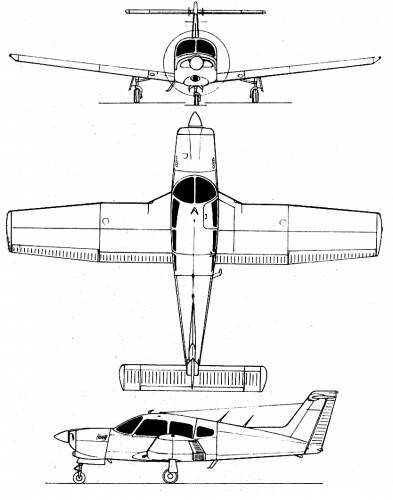AD 2020-26-16 Was Prompted By A Report Of A Wing Separation
The FAA is adopting a new airworthiness directive (AD) for certain Piper Aircraft, Inc. (Piper) Models PA-28-151, PA-28-161, PA-28-181, PA-28-235, PA-28R-180, PA-28R-200, PA28R-201, PA-28R-201T, PA-28RT-201, PA-28RT-201T, PA-32-260, PA-32-300, PA-32R-300, PA32RT-300, and PA-32RT-300T airplanes.

This AD was prompted by a report of a wing separation caused by fatigue cracking in a visually inaccessible area of the lower main wing spar cap. This AD requires calculating the factored service hours for each main wing spar to determine when an inspection is required, inspecting the lower main wing spar bolt holes for cracks, and replacing any cracked main wing spar. The FAA is issuing this AD to address the unsafe condition on these products. This AD is effective February 16, 2021.
Supplementary Information: The FAA issued a notice of proposed rulemaking (NPRM) to amend 14 CFR part 39 by adding an AD that would apply to certain Piper Models PA-28-140, PA-28-150, PA-28-151, PA-28-160, PA-28-161, PA-28-180, PA-28-181, PA-28-235, PA-28R-180, PA-28R-200, PA-28R-201, PA-28R201T, PA-28RT-201, PA-28RT-201T, PA-32-260, and PA-32-300 airplanes. The NPRM published in the Federal Register on December 21, 2018 (83 FR 65592). The NPRM was prompted by a fatal accident involving wing separation on a Piper Model PA-28R-201 airplane. An investigation revealed a fatigue crack in a visually inaccessible area of the lower main wing spar cap. The NPRM included other model airplanes with similar wing spar structures as the Model PA-28R-201. Based on airplane usage history, the FAA determined that only those airplanes with higher risk for fatigue cracks (airplanes with a significant history of operation in flight training or other high-load environments) should be subject to the inspection
requirements proposed in the NPRM.
Because airplanes used in training and other high-load environments are typically operated for hire and have inspection programs that require 100-hour inspections, the FAA determined the number of 100-hour inspections an airplane has undergone would be the best indicator of the airplane's usage history. Accordingly, the FAA developed a factored service hours formula based on the number of 100-hour inspections completed on the airplane.
In the NPRM, the FAA proposed to require a review of the airplane maintenance records to determine the number of 100-hour inspections and the application of the factored service hours formula to identify when an airplane meets the criteria for the proposed eddy current inspection of the lower main wing spar bolt holes. The FAA also proposed to require inspecting the lower main wing spar bolt holes for cracks once a main wing spar exceeds the specified factored service hours and replacing any main wing spar when a crack is indicated. The maintenance records review to determine the factored service hours proposed in the NPRM would only apply when an airplane has either accumulated 5,000 or more hours time-in-service (TIS); has had either main wing spar replaced with a serviceable (more than zero hours TIS) main wing spar; or has missing and/or incomplete maintenance records.

The FAA issued a supplemental notice of proposed rulemaking (SNPRM) to amend 14 CFR part 39 by adding an AD that would apply to certain Piper Models PA-28-151, PA-28-181, PA-28-235, PA-28R-180, PA-28R-200, PA-28R-201, PA-28R-201T, PA-28RT-201, PA-28RT-201T, PA-32-260, PA-32-300, PA-32R-300, PA-32RT-300, and PA-32RT-300T airplanes. The SNPRM published in the Federal Register on June 3, 2020 (85 FR 34121). The SNPRM was prompted by comments received on the NPRM and further analysis by the FAA. The FAA determined that some additional airplane models are likely affected by the unsafe condition and should be included in the applicability, while other models that are not affected should be removed from the applicability.
Consequently, in the SNPRM, the FAA proposed to revise the applicability and the estimated cost associated with the proposed AD actions. The SNPRM also clarified the language in the applicability and some of the proposed actions. In addition, the SNPRM no longer allowed replacement of the wing spar with a used part. The FAA determined replacement of the wing spar with a part of unknown operational history would not ensure an acceptable level of safety. After the NPRM was published, Piper issued a service bulletin that contains procedures for the eddy current inspection.
The SNPRM proposed to require using the eddy current inspection contained in that service bulletin instead of the inspection procedure in the appendix to the NPRM. The FAA developed a flow chart that may assist operators in complying with this AD. The flow chart may be found at https://www.regulations.gov by searching for and locating Docket No. FAA2018-1046. The FAA is issuing this AD to address the unsafe condition on these products.
 Airborne-Flight Training 05.09.24: ERAU at AIAA, LIFT Diamond Buy, Epic A&P
Airborne-Flight Training 05.09.24: ERAU at AIAA, LIFT Diamond Buy, Epic A&P ANN's Daily Aero-Term (05.07.24): Hazardous Weather Information
ANN's Daily Aero-Term (05.07.24): Hazardous Weather Information Aero-News: Quote of the Day (05.07.24)
Aero-News: Quote of the Day (05.07.24) NTSB Final Report: Cessna 150
NTSB Final Report: Cessna 150 Aero-News: Quote of the Day (05.08.24)
Aero-News: Quote of the Day (05.08.24)




